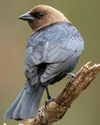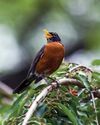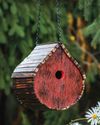
Walking into a pine grove, you hear soft, unfamiliar calls overhead. Looking up, you see a dozen small birds clambering about over the pine cones, acting like tiny parrots. Some are red, some are dull yellow-green. Take a good look: These are crossbills, and they may stay put for a month or maybe a hundred miles away tomorrow. Two species, red crossbill and white-winged crossbill, are widespread in North America. And they’re among the most unusual birds in the world.
UNIQUE BEAKS
When you look at a crossbill’s face, it’s obvious how it got its name. The bill is thick at the base, but the mandibles cross over each other instead of meeting at their narrow tips. This shape would be awkward for picking up most items, but it’s perfect for one thing—prying open the cones of pines, spruces, hemlocks and other evergreens.
For most small birds, getting seeds out of a cone is too complicated to be worth the effort. For crossbills, it’s a snap. The bird inserts its bill between two cone scales and then closes it so that the crossed tips push the scales apart. Twisting its head, the bird works to reach the seed buried between the scales. Using its tongue against grooves on the inside of its bill, it pulls out the seed, cracks the dry husk and swallows the kernel. This happens in a lot less time than it takes to describe it—a crossbill can extract and eat more than 20 seeds per minute, which means better than one every three seconds!
This story is from the October/November 2020 edition of Birds & Blooms.
Start your 7-day Magzter GOLD free trial to access thousands of curated premium stories, and 8,500+ magazines and newspapers.
Already a subscriber ? Sign In
This story is from the October/November 2020 edition of Birds & Blooms.
Start your 7-day Magzter GOLD free trial to access thousands of curated premium stories, and 8,500+ magazines and newspapers.
Already a subscriber? Sign In

Clever Cowbirds
Learn more about these birds that are infamous for letting others raise their young

Ask the Experts
Pros offer spring plant care tips and tough IDs

Rustic diy Birdhouse
Whether you're hardcore handy or an everyonce-in-a-while crafty person, you probably have a small pile of scrap wood handy. Grab your tools and turn your extra materials into any house wren's dream nest box.

THE LATEST IN Lilacs
Learn about updated varieties of this timeless classic and how to take care of them

Meet the ORIOLES
GET TO KNOW eight TYPES SEEN THROUGHOUT THE U.S. AND WHAT MAKES EACH ONE STAND OUT

CBD FOR YOUR PAIN
Everyone feels the hurt as you age, but CBD can help you deal with it

Welcome, New Blooms
Update your yard with 2024's freshest florals

Western Blues
Beckon these regional bluebirds to your yard with nest boxes and mealworms

Incredible Eggs
Fun facts about these tough yet fragile wonders

Life Well Lived
Surprising facts about bird life spans